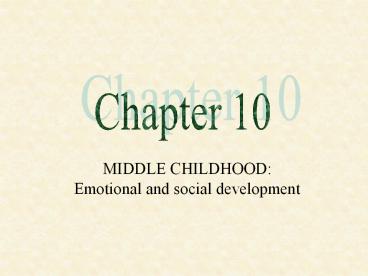MIDDLE CHILDHOOD: Emotional and social development - PowerPoint PPT Presentation
Title:
MIDDLE CHILDHOOD: Emotional and social development
Description:
Erikson's Stage of Industry Versus Inferiority ... Children fashion coherent gender-based identity. Maccoby - Factors for segregation: ... – PowerPoint PPT presentation
Number of Views:1004
Avg rating:3.0/5.0
Title: MIDDLE CHILDHOOD: Emotional and social development
1
Chapter 10
- MIDDLE CHILDHOOD Emotional and social
development
2
The Quest for Self-Understanding
3
Erickson
- Eriksons Stage of Industry Versus Inferiority
- Self-Image The overall view that children have
of themselves.
4
Self-Esteem
- Coopersmith Parental attitudes associated with
development of high self-esteem. - High self-esteem accepting of children
- Enforced clearly-defined limits
- Respect for childrens rights and opinions
5
(No Transcript)
6
Self-Regulated Behaviors
- Emotionally Disturbed (ED) children Cannot
control their over-impulsive or aggressive
behaviors toward others.
7
Understanding Emotion
- Fear unpleasant emotion aroused by impending
danger, pain or misfortune. - Phobia excessive, persistent and maladaptive
fear response. - Stress process involving the recognition of and
response to a threat or danger.
8
Coping
- The responses we make in order to master,
tolerate, or reduce stress - Problem-focused
- Emotion-focused
9
Locus of control
- Our perception of who or what is responsible for
the outcome of events and behaviors in our lives. - Trauma any extremely stressful event that
affects a childs emotional and psychological
well-being.
10
Continuing Family Influences
11
Mothers and Fathers
- Employed Mothers
- 77 of all mothers work.
- Caregiving Fathers
12
Sibling Relationships
- Average of three children under age 18 in
household - Stepsiblings, half-brothers, half-sisters,
adopted siblings, nonrelated siblings
13
Children of Divorce
- Wallerstein and Kelly tasks for child
- Accept divorce
- Get back to previous routine
- Resolve the loss of the family
- Resolve anger and self-blame forgive
- Accept permanence of divorce
- Believe in relationships
14
Single-Parent Families
- Bray and Heatherington
- If children have a good relationship with the
single parent and income stress is not a factor,
they are inclined to be better adjusted than if
they remain in a two-parent home that is a
divided and hostile environment.
15
Stepfamilies
- 75-80 of divorced parents remarry.
- Reconstituted or blended families
16
(No Transcript)
17
Later Childhood The Broadening Social
Environment
18
The World of Peer Relationships
- Peer relationships assume a vital role in
childrens development.
19
Developmental Functions of Peer Groups
- Arena in which children can exercise independence
from adult control - Experience relationships with equal footing with
others - Position of children is not marginal
- Peer groups transmit informal knowledge.
20
Gender Cleavage
- The tendency for boys to associate with boys and
girls with girls - Children fashion coherent gender-based identity.
- Maccoby - Factors for segregation
- Differing styles for interacting
- Girls have difficulty influencing boys
21
(No Transcript)
22
Popularity, Social Acceptance and Rejection
- Group two or more people who share a feeling of
unity and are bound together in relatively stable
patterns of social interactions
23
Values
- Criteria people use in deciding the relative
merit and desirability of things - Sociogram depicts patterns of choice among
members of a group.
24
Physical Attractiveness
- Culturally defined
25
Behavioral characteristics
- Popular
- Successful
- Unpopular
- Social isolates
- Introverted
- Overbearing, aggressive
26
(No Transcript)
27
Social Maturity
- Increases during early school years
28
Racial Awareness and Prejudice
- Prejudice a system of negative conceptions,
feelings and action orientations regarding the
members of a particular religious, racial, or
nationality group
29
The World of School
30
Developmental Functions
- Teach specific cognitive skills
- Share with family responsibility for transmitting
cultural goals and values - Serve as sorting and sifting agency selecting
young people for upward social mobility
31
Motivating Students
- Motivation the inner states and processes that
prompt, direct, and sustain activity. - Intrinsic undertaken for its own sake.
- Extrinsic undertaken for some purpose other
that its own sake. - Causality factors that produce given outcomes.
32
Social Class
- The higher the social class
- Greater number of grades children complete
- Greater participation in extracurricular
activities - Higher scores on achievement tests
- Lower rates of failure, truancy, suspensions and
dropping out
33
Middle-Class Bias
- Middle-class teachers, unaware of prejudice, find
lower socioeconomic status students unacceptable - Subcultural Differences
- Different experiences and attitudes
- Educational Self-Fulfilling Prophecies
- Teacher expectation effects
34
(No Transcript)































